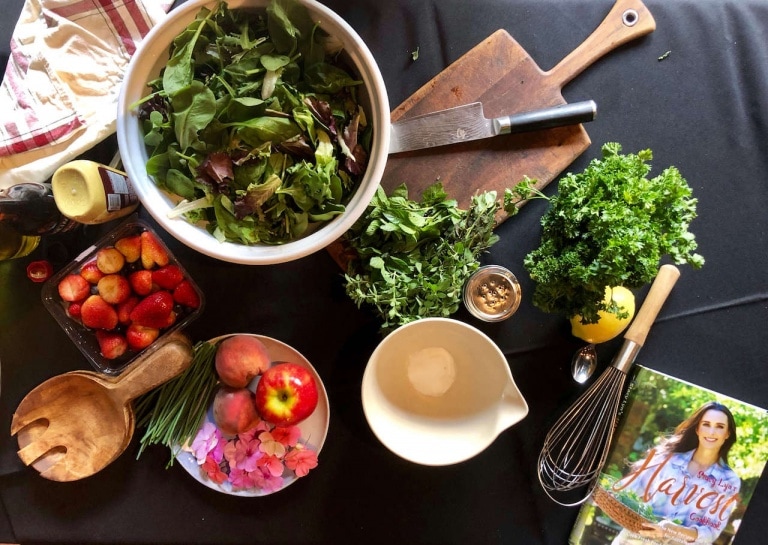Ceramic vs Teflon and More: What Is the Best Cookware?
Nonstick cookware: what kinds are the best to use and easiest to care for? What are the pros and cons of ceramic pans vs. Teflon non-stick pans vs. a cast-iron skillet? Which hold up under high heat, and which are safe and durable? Are there any health considerations?
My kitchen is the center of my home and life: it’s where I nourish my family, express my creativity, and develop new recipes to share with you. So I’ve put a whole lot of thought and field testing into questions like these. With seven kids, I’ve cooked in and washed up just about every kind of pots and pans you can think of. In this post I’ll share what I’ve learned as well as my top picks.

The number of choices can be overwhelming. Some types of cookware I have used include:
- stainless steel cookware
- hard-anodized aluminum
- pans with Teflon non-stick coating
- 100% ceramic cookware (wonderful but hard to find!)
- pots, pans, and Dutch oven with ceramic or enamel coating
- seasoned cast iron skillets (a personal favorite)
Here are some pros and cons of the main types.
What is the best material for cookware for everyday use?
There’s no question that nonstick or stick-resistant pans make kitchen cleanup easier. Nonstick coatings also help keep dishes with eggs and other fragile foods, like this herb frittata, from falling apart in the pan. So what are your options?
The main choice isn’t really between ceramic vs nonstick cookware. Ceramic has nonstick properties, too. So your options are nonstick or stick resistant cookware coated with enamel or ceramic vs. cookware coated with Teflon and other chemicals. Or you can go old school with seasoned cast iron! I’ll start with that last option.
Seasoned Cast Iron Pans

Don’t discount those cast iron pans like our grannies used! The naturally slick surface of oil-seasoned cast iron makes it essentially a nonstick skillet. I’ve found that cast iron cookware also possesses a larger heat capacity than all of my copper and aluminum nonstick pans. One caveat, aside from the heavy weight: cast iron reacts to highly acidic foods, so avoid simmering tomatoes in the skillet, for example. For tomato soups and sauces, I like to use a stainless steel stockpot.
Learn more about caring for your cast iron skillet here.
Teflon-Coated Pots and Pans
Teflon-coated aluminum pans became the non-stick cookware of choice in the 1970s. Teflon is also known as PTFE coating. The pros? Teflon pans are lightweight, and the nonstick coating really works: food slides off easily. However, there are also some pretty big cons: Teflon may release toxic fumes at high heat, and scratches in the surface of a pan may result in unhealthy chemicals in your food. Teflon is not scratch-resistant. If you do use it, stick with plastic or silicone nonstick-safe utensils, and be extra careful to avoid scratching the surface of the pan.
Note: For safer nonstick aluminum, try hard-anodyzed aluminum cookware.
Enamel and Ceramic Nonstick Cookware
Enameled cast iron like a fine-quality Le Crueset pot is really the best of both worlds: it has superior heat distribution with a durable finish that minimizes sticking. I have two Le Crueset Dutch ovens and use them all the time. You can also find lighter and more budget-friendly enamel pots with an aluminum core.
Stacy Lyn’s Pick:

However, if you want true nonstick, then ceramic coated cookware is a great choice for everyday cooking. One huge benefit of a nonstick ceramic coating is that it is free from harmful chemicals, such as PTFE and PFOA, which are found in many other non-stick pans. Another is that it withstands very high heat (but check the specifications).
Stacy Lyn’s Pick:
First, though, “ceramic” can mean two different things. 100% ceramic cookware has no metal core. Instead, the inner core consists of clay, earthen materials, and water. It is glazed and then fired in a kiln at high temperatures. Pure ceramic is wonderful, but it’s super expensive and hard to find. Instead, “ceramic” usually means ceramic nonstick cookware with an aluminum core and silicon-based coating (made from sand). The coating gets its name from its super-slick, shiny, ceramic-like surface.
Is nonstick ceramic cookware safe to use?
Yes! Good quality ceramic coating is non-toxic and heats evenly. Just be sure to stick with a reputable brand, and to discard old, chipped pots. You do not want to be buying a scratched-up ceramic saucepan at a yard sale. The coating can wear off over time, so like Teflon nonstick, ceramic needs to be handled with care. For this reason I recommend you hand wash your ceramic cookware even if it’s marked dishwasher-safe.
TIP: Instead of buying a whole 12-piece ceramic cookware set, I suggest getting the best quality essential pieces or small sets separately. This is the best budget option for cookware that will fit most uses and also last a long time. For starters, I recommend purchasing a 10-inch to 12-inch frying pan, a 12-quart stockpot or Dutch oven and lid, and a straight-sided sautè pan with tall sides. Tempered glass lids will increase the versatility of these pieces.
Is ceramic oven-safe? Always to some degree, but the heat tolerance varies! Check the brand’s specifications before you buy, and check the maximum safe temperature. Not all ceramic coated cookware is safe at very high heats; some may warp. This 3pc ceramic coated baking dish set is safe up to 572°F.
Why do chefs only use stainless steel pans?
You may be thinking, but wait: don’t chefs prefer stainless steel? It’s true that stainless steel has some wonderful benefits. These include extra durability, the ability to handle high heat, even heat distribution, a non-reactive surface, and fairly easy cleaning. You can use metal utensils with stainless steel, and it also browns foods better than those slick nonstick surfaces.

However, for a busy home cook, the ease and convenience of nonstick cookware can’t be beat.
In conclusion…
You don’t have to choose just one or another cookware type. And you definitely don’t have to choose between ceramic vs nonstick cookware because the former is in fact the best nonstick option. I like to buy the essential pieces separately and keep a variety of cookware on hand for different types of cooking and baking. Let me know your favorite kinds of cookware in the comments!
*This post contains Amazon affiliate links. As an Amazon Associate I earn from qualifying purchases.







I have all of the above! I like enameled cast iron dutch ovens for their even heating and heat retention.
I have nonstick, stainless and cast iron fry pans. I use cast iron for steaks and chops. I like to use the stainless for frying things like chicken cutlets. I use nonstick for most everything else.
I have a ceramic pan or two and the nonstick characteristic of these are unlike any other pan I have.
My saucepans are nonstick. Stock pot is also, but it’s because it came with the set.
Bakeware is mostly nonstick and when it’s not, I use aluminum foil or parchment.
Stacy thank you for all this great information
I’m so glad you liked it!!